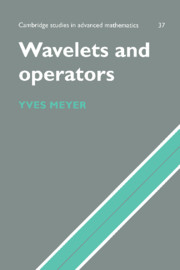Book contents
- Frontmatter
- Contents
- Dedication
- Preface to the English Edition
- Introduction
- 1 Fourier series and integrals, filtering and sampling
- 2 Multiresolution approximations of L2(ℝn)
- 3 Orthonormal wavelet bases
- 4 Non-orthogonal wavelets
- 5 Wavelets, the Hardy space H1 and its dual BMO
- 6 Wavelets and spaces of functions and distributions
- Bibliography
- New references on wavelets and their applications
- Index
Introduction
Published online by Cambridge University Press: 24 December 2009
- Frontmatter
- Contents
- Dedication
- Preface to the English Edition
- Introduction
- 1 Fourier series and integrals, filtering and sampling
- 2 Multiresolution approximations of L2(ℝn)
- 3 Orthonormal wavelet bases
- 4 Non-orthogonal wavelets
- 5 Wavelets, the Hardy space H1 and its dual BMO
- 6 Wavelets and spaces of functions and distributions
- Bibliography
- New references on wavelets and their applications
- Index
Summary
For many years, the sine, cosine and imaginary exponential functions have been the basic functions of analysis. The sequence (2π)−1/2eikx, k = 0, ±1, ±2, … forms an orthonormal basis of the standard space L2[0, 2π]; Fourier series are the linear combinations. Their study has been and remains, an unquenchable source of problems and discoveries in mathematical analysis. The problems arise from the absence of a good dictionary for translating the properties of a function into those of its Fourier coefficients. Here is an example of the kind of difficulty that occurs. J.P. Kahane, Y. Katznelson and K. de Leeuw have shown ([150]) that, to get a continuous function g(x) from an arbitrary square-summable function ƒ(x), it is sufficient to increase—or leave unchanged—the moduli of the Fourier coefficients of ƒ(x) and to adjust their phases judiciously. It is thus impossible to predict the properties (size, regularity) of a function solely from knowledge of the order of magnitude of its Fourier coefficients. Indeed it is still difficult if we know the Fourier coefficients explicitly, and many problems are still open.
At the beginning of the 1980s, many scientists were already using “wavelets” as an alternative to traditional Fourier analysis. This alternative gave grounds for hoping for simpler numerical analysis and more robust synthesis of certain transitory phenomena. The “wavelets” of J.S. Liénard or of X. Rodet ([167], [206]) were used for numerical treatment of acoustic signals (words or music) and those of J. Morlet ([124]) for stocking and interpreting seismic signals gathered in the course of oil prospecting expeditions.
- Type
- Chapter
- Information
- Wavelets and Operators , pp. xi - xviPublisher: Cambridge University PressPrint publication year: 1993
- 1
- Cited by

